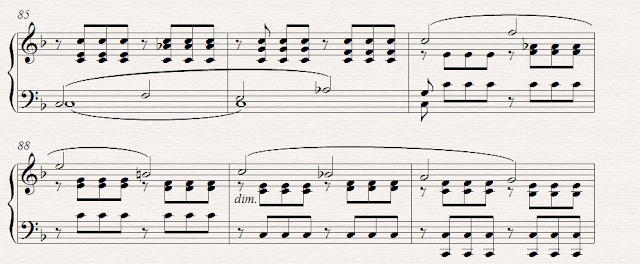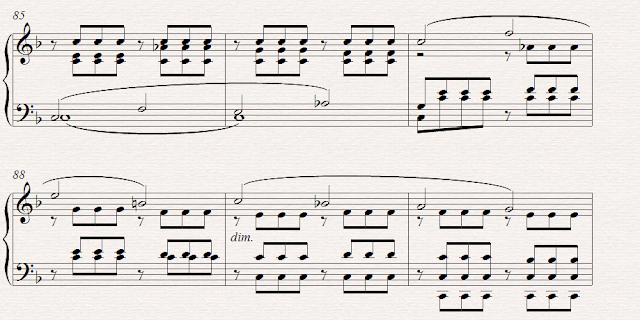In the piano version, the second phrase of the retransition (measures 85 to 88) is an exact repetition of the first phrase. Measures 89 to 90 then lead back to F major for the recapitulation:
A literal transcription follows:
In the string arrangement, Beethoven treats each phrase differently. We discussed measures 81 to 84 last week, but I repeat them here for comparison:
In measure 85, the cello plays the theme an octave lower than in the first phrase. (This answers the first question from last week. The low Cs at the end of measure 84 were preparation for this octave drop.) The viola plays the same notes as before (also an octave lower) but now plays half notes instead of eighth notes. Together, these changes reinforce the feeling of a stretto that Beethoven began in the first phrase. The entrance of the theme in a new octave sounds like a new voice, a fourth statement of the subject. The half notes in the viola sound like a counter subject, and the fact that the half notes begin on beat three rather than beat one reinforces this impression.
The violins play the eighth note accompaniment, but with a twist. Instead of repeated Cs, each triple begins with a B natural, the dominant leading tone. This adds variety to the second phrase, but I think there is a more subtle reason for this change that will become apparent later on. We can now answer the second question from last week. Why did Beethoven not resolve the B natural in the second violin part? He does; he just waits until beat two to resolve it.
In measure 87, we have the final entrance of the subject in the first violin. The second violin joins the viola in playing half notes while the cello takes over the eighth-note accompanimental figure. Having three voices playing half notes and one playing eighth notes (rather than the other way around, as in the piano version) lends the serenity to this passage that a retransition requires. Note the cello omits the B natural in the second triple of each measure, thus avoiding a cross relation in measure 89.
As expected, Beethoven revoices the chords in measures 87 and 88 to avoid the parallel octaves. But why does he give the viola the higher part? Presumably because lower part is the counter-subject, which the viola has already played. In fugal writing, each entrance of the subject or counter-subject is taken up by a new voice. So Beethoven is simply continuing to treat this passage as a stretto.
In measure 89, Beethoven starts the modulation to the home key of F major. Purists will object to calling this a modulation. Technically, going from F minor to F major is a mode shift, not a modulation. But it certainly feels like a modulation. The B-flat in the melody has a definite turning-the-corner-and-heading-back-to-home feel to it. And that, I think, is why Beethoven added all those B naturals to the accompaniment. He wanted B natural ringing in our ears, so the B flat would have this effect.
At the very end of the phrase, Beethoven adds an eighth note C to the melody. Again, he is paying close attention to voice leading. Without that eighth note, we would expect the next note in the first violin to be an F. But, since the next measure starts the recapitulation, it is going be a C. This added eighth note keeps that C from sounding incongruous. In the piano version, the eighth note is unnecessary, because we can hear the return of the opening theme as a new voice rather than as a continuation of this line. (A sensitive pianist would certainly play it that way.)
One last thing to puzzle through is the change in dynamics. In the piano version, Beethoven writes a diminuendo in this passage. In the string version, he drops to pianissimo and crescendos. Why this change? I suspect it is due to what happens next. In the piano version, the recapitulation begins forte. In the string version, it will begin piano (for reasons we will consider next week). Beethoven wants a sudden dynamic shift at the start of the recapitulation. So, if it is going to start piano, he must change the diminuendo in this passage to a crescendo.



No comments:
Post a Comment